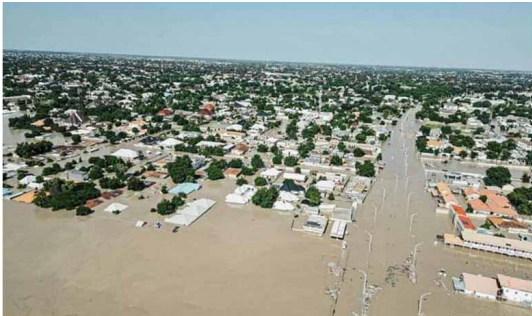BY AMAYINDI YAKUBU
The recent flood in Maiduguri that left half of the city submerged and people devastated is said to be the worst in thirty years.
An aerial view of the old Kanuri city in northern Nigeria revealed a submerged environment, leading to the escape of animals from the zoo into the streets. About one million people have been affected, leaving thousands displaced. Thirty people have reportedly died in the flood.
Being a city that has been a victim of insurgency caused by Boko Haram and other terror groups, the new wave of flooding also led to the escape of some top Boko Haram leaders from prison. The plight of the people extends beyond the destruction of property to security concerns, as these escapees remain at large.
Alua Dam, located in a community called Kunuga a few kilometers from Maiduguri, burst after reaching its limit, forcing water to gush from the riverbank. This occurred due to heavy rainfall, which overwhelmed the dam and led to the catastrophic event.
Built in 1986 to assist local farmers with irrigation around the Maiduguri province, the dam also controls flooding from the Ngadda River, which occasionally receives more water than normal from Lake Chad.
This is not the first time the dam has burst. In 1994, it broke as a result of heavy rainfall, flooding Maiduguri and its surroundings. Another flood event occurred in 2012, affecting nearby communities.
Speaking about the impact of the flood, the chief medical officer of the 1,305-bed University of Maiduguri Teaching Hospital, Dr. Ahmed Ahidjo, the largest in northern Nigeria, lamented the state of the hospital during the flood: “I have been in this hospital for the last 37 years and I have never seen anything like this,” he said.
Dr. Ahmed revealed that the entire ground floor and fourteen other specialized centers, where patients had been hospitalized, were submerged, along with expensive medical equipment.
Amidst this dilemma, wild animals such as crocodiles, lions, hyenas, and snakes escaped from the Kyarimi Park Zoo in Maiduguri. In a video circulating on social media, an ostrich was seen walking freely around Maiduguri streets.
The empirical predictions by the Federal Ministry of Water Resources and Sanitation, in conjunction with the Nigeria Hydrological Services Agency (NIHSA), are rapidly being fulfilled like a divine prophecy.
As part of NIHSA’s routine of releasing a comprehensive Annual Flood Outlook, 148 local government areas across the federation fall within high flood-risk zones, 249 local government areas are within moderate flood-risk zones, and 377 local government areas fall within low flood-risk zones.
Significantly, 31 states were identified as high-risk flood areas, including Adamawa, Akwa-Ibom, Anambra, Bauchi, Bayelsa, Benue, Borno, Cross River, Delta, Ebonyi, Edo, Gombe, Imo, Jigawa, Kaduna, Kano, Kebbi, Kogi, Kwara, Lagos, Nasarawa, Niger, Ogun, Ondo, Osun, Oyo, Rivers, Sokoto, Taraba, Yobe, Zamfara, and the Federal Capital Territory (FCT).
In July alone, 21 local government areas were submerged by floods across ten states and the Federal Capital Territory (FCT), Abuja, due to torrential rainfall over the past few weeks.
Nigerian Minister of Water Resources andSanitation, Joseph Utserv, while presenting the Annual Flood Outlook in April, revealed that some states had already experienced different levels of flooding and associated disasters. He identified poor drainage systems and high rainfall as the major reasons for flooding in the initial stages.
Beyond Africa, millions of people in South Asia are currently facing the devastating impact of flooding, with 200 deaths already recorded. Myanmar, Thailand, Laos, and Vietnam are among the areas battling flood disasters.
The United Nations International Children’s Fund (UNICEF) disclosed that a typhoon destroyed more than 140,000 homes in 26 provinces in Vietnam. Power cuts, flooded homes, and wrecked infrastructure have become the plight of these Asians. Vietnam alone has mourned 197 fatalities. Thailand has confirmed nine deaths so far, with one district recording its worst flood in 80 years.
In Myanmar, 17 bodies were recovered from flooded villages, leaving more than 50,000 people displaced. According to AFP, a farmer in Hanoi revealed that his 1,000-square-meter plantation was washed away by the flood. Lamenting, “It will be so hard for me to recover from this loss. I think I will lose up to $40,000 this season,” said the farmer named Tu.
TheDirector-GeneraloftheNationalEmergencyManagementAgency(NEMA),Zubaida Umar, revealed that 259 people have lost their lives due to floods across Nigeria from April to September 2024. Zubaida, speaking at the national emergency coordination forum in Abuja, stated that 625,239 people are displaced, and 1,048,312 people are severely affected by the floods.
The impact of the floods has already been felt in 172 local government areas across 29 states between April and September. Regarding the agency’s efforts to mitigate the impact of the floods, Umar stated, “NEMA has activated Internally Displaced Persons (IDP) camps in some states and deployed additional staff to support search and rescue operations. The agency has also provided water purification equipment and critical search and rescue tools to affected states.”
While the relief measures put in place by the federal government have been beneficial to flood victims, more practical steps need to be taken to ensure sustainability. Constructing proper drainage systems across the states will go a long way in reducing the impact of annual flood events.
Building more dams in Nigeria should remain a top priority for the federal government. Nigeria’s large water bodies need to be adequately channeled and controlled for our benefit. The creation of dams will not only control floods but also generate electricity if utilized properly.
In areas where houses are built on waterways, the government needs to find ways to evacuate people from such residential buildings before demolishing them. Local urban and town planning commissions should regularly check for proper adherence to housing regulations, which remains crucial.
For the people, especially locals living near riverbanks, states and the National Emergency Management Agency (NEMA) should educate them to evacuate during flood-prone times. Farmers are also advised to heed the annual predictions of the Nigeria Hydrological Services Agency (NIHSA) to avoid losing farm investments.


